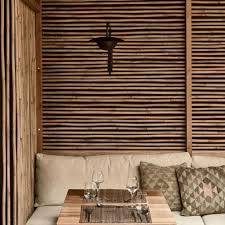In recent years, there has been a noticeable shift in interior design. As people become more attuned to sustainability and the importance of connecting with nature, a growing trend has emerged in the world of interior decor: the use of natural materials. Whether it’s stone, wood, clay, or linen, these materials are bringing a sense of authenticity, warmth, and tranquility to modern interiors. But this isn’t just about aesthetics; it’s also about fostering healthier, more sustainable living spaces.
The Return to Nature

For decades, interior design has been dominated by sleek, man-made materials like plastic, glass, and metals, often offering a clean, futuristic look. However, as the global conversation around sustainability and environmental awareness grows, there’s been a notable return to natural materials that bring the outdoors in. Homeowners and designers are increasingly looking for ways to create spaces that not only feel luxurious but also reconnect us with nature.
Natural materials carry an inherent beauty due to their textures, colors, and imperfections. A piece of furniture made from reclaimed wood or a marble countertop with visible veining brings character and timeless elegance. More importantly, these materials often age gracefully, developing a patina that only adds to their charm, unlike synthetic materials that tend to deteriorate or look dated over time.
Why Natural Materials?
- Sustainability and Eco-Friendliness
One of the key reasons behind the surge in popularity of natural materials is sustainability. Many natural materials, when sourced responsibly, are biodegradable, renewable, and have a lower environmental impact than synthetic alternatives. For example, cork, bamboo, and wool are all rapidly renewable resources that can be harvested with minimal environmental disruption. Even when these materials do reach the end of their life cycle, they can decompose without causing harm to the planet.
In addition, choosing natural materials for interiors can significantly reduce a home’s carbon footprint. Materials like stone, clay, and wood tend to require fewer resources to manufacture and can be sourced locally, further reducing the environmental cost of transportation.
- Health and Well-Being
Natural materials are often healthier for both the environment and the inhabitants of the space. Many synthetic materials, such as certain plastics and synthetic fibers, emit volatile organic compounds (VOCs) that can contribute to indoor air pollution, which may have adverse effects on human health.
On the other hand, natural materials tend to have fewer chemicals and allergens. For example, wood, stone, and clay are non-toxic and promote better indoor air quality, making them ideal for those with sensitivities or allergies. Furthermore, the organic textures and colors of natural materials create a sense of calm and relaxation, which can enhance the overall well-being of the people living in the space.
- Timeless Aesthetic
Another reason natural materials have made a comeback is their timeless aesthetic. Materials like marble, stone, wood, and linen are classic choices that never go out of style. Unlike trendy, mass-produced materials, they bring a sense of authenticity and character to the home. Whether you’re designing a minimalist modern apartment or a cozy rustic retreat, natural materials can be incorporated into any style, blending seamlessly with both contemporary and traditional designs.
Popular Natural Materials in Modern Interiors
- Wood
Wood has always been a staple in interior design, but its presence is being embraced now more than ever. From hardwood floors to custom cabinetry, wooden elements are making a comeback in modern interiors. The natural grain, texture, and color variations of wood bring warmth and depth to spaces.
Reclaimed wood, in particular, is highly sought after. Using salvaged wood not only gives a second life to a material but also brings a sense of history and uniqueness to any room. Whether it’s used in furniture, flooring, or accent walls, wood is the perfect material to create a cozy, organic vibe.
- Stone
Stone, particularly marble, granite, and slate, is being incorporated into both functional and decorative elements. Whether used in countertops, backsplashes, or fireplace surrounds, stone adds a touch of luxury and permanence to any room. The unique veining of marble or the earthy tones of slate can make a striking statement in both kitchens and bathrooms.
Natural stone also brings a tactile quality to interiors, with its cool, solid surface providing contrast to the softer textures of wood and textiles. Additionally, stone is highly durable and long-lasting, making it a sustainable choice in the long run.
- Bamboo
Bamboo is a fast-growing, renewable resource that has found its way into modern interiors. It is used for everything from flooring to furniture and accessories. Lightweight yet strong, bamboo is an eco-friendly alternative to traditional hardwoods. Its light color and clean lines make it a popular choice for contemporary spaces, especially in areas where minimalism reigns.
- Clay and Terracotta
Clay, terracotta, and other earthen materials are making a comeback in interiors, particularly in flooring, tiles, and pottery. The rich, earthy tones of terracotta add warmth and texture, making it an ideal material for both rustic and modern interiors. Whether used for wall tiles, decorative vases, or sculptural elements, clay offers a grounded and tactile aesthetic that feels timeless.
Linen and Natural Fabrics
Natural fabrics like linen, cotton, and wool are becoming the go-to choices for everything from upholstery to bedding and curtains. Linen, in particular, is prized for its breathable, durable, and sustainable properties. Its natural texture brings a relaxed, laid-back vibe to interiors while remaining sophisticated.
Incorporating Natural Materials into Your Home

If you’re thinking about incorporating natural materials into your own space, it’s essential to strike a balance. Too much wood or stone can make a space feel heavy or overly rustic. Instead, mix and match these materials with more neutral tones and contemporary finishes to create a modern, harmonious interior.
Consider starting small by adding natural elements like wooden shelves, stone accents, or linen cushions. From there, you can gradually introduce more prominent features like a reclaimed wood dining table or a stone feature wall.
Conclusion
The trend of using natural materials in modern interiors is more than just a passing fad—it’s a reflection of our growing desire to connect with nature, live sustainably, and create spaces that promote well-being. By incorporating materials like wood, stone, and linen into our homes, we can create environments that are not only beautiful and timeless but also healthier and more eco-friendly. As we continue to prioritize sustainability and authenticity in design, natural materials will undoubtedly remain at the forefront of interior design for years to come.





